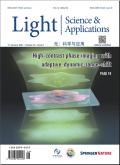Surpassing 99% detection efficiency by cascading two superconducting nanowires on one waveguide with self-calibration.
IF 23.4
Q1 OPTICS
引用次数: 0
Abstract
Integrated quantum photonics (IQP) allows for on-chip generation, manipulation and detection of quantum states of light, fostering advancements in quantum communication, quantum computing, and quantum information technologies. Single-photon detector is a key device in IQP that allows for efficient readout of quantum information through the detection of single-photon statistics and measurement of photonic quantum states. The efficacy of quantum information retrieval hinges on the ability to simultaneously detect every single photon with high efficiency, a relationship that grows exponentially with the number of photons (n). Even a slight decrease in single photon detection efficiency can lead to a significant reduction in probability as n grows larger. Here, we introduce a superconductor-semiconductor heterogeneous integration technology that allows for the integration of transversal superconducting nanowires single-photon detectors that eliminate corner loss on various optical waveguides with exceptional efficiency and versatility. Two cascaded nanowires have been integrated on one silicon waveguide, which not only boosts the detection efficiency to 99.73% at a wavelength of 1550 nm but also provides an on-chip calibration setup, allowing such high efficiency to be measured despite the large loss from fiber-to-waveguide coupling and uncertainties from absolute power calibrations. These advancements represent a substantial improvement compared to previous records, approaching the theoretical limit achievable on silicon waveguide, and demonstrate the versatility of heterogeneous integration technology. This breakthrough in ultra-high detection efficiency establishes a new baseline for assessing quantum measurement capabilities on scalable IQP platforms.通过将两根超导纳米线级联在一个波导上进行自校准,检测效率超过99%。
集成量子光子学(IQP)允许在芯片上生成、操纵和检测光的量子态,促进量子通信、量子计算和量子信息技术的进步。单光子探测器通过检测单光子统计量和测量光子量子态来实现量子信息的高效读出,是量子量子信息处理中的关键器件。量子信息检索的有效性取决于同时以高效率检测每个光子的能力,这种关系随着光子数量(n)呈指数增长。随着n的增大,单光子探测效率的微小降低也会导致概率的显著降低。在这里,我们介绍了一种超导体-半导体异质集成技术,该技术允许集成横向超导纳米线单光子探测器,以卓越的效率和通用性消除各种光波导上的角落损耗。两个级联的纳米线集成在一个硅波导上,不仅在1550 nm波长下将检测效率提高到99.73%,而且还提供了片上校准设置,尽管光纤-波导耦合的大损耗和绝对功率校准的不确定性,但仍然可以测量如此高的效率。与以前的记录相比,这些进步代表了实质性的改进,接近硅波导可实现的理论极限,并展示了异构集成技术的多功能性。这一在超高检测效率方面的突破为评估可扩展IQP平台上的量子测量能力建立了新的基线。
本文章由计算机程序翻译,如有差异,请以英文原文为准。
求助全文
约1分钟内获得全文
求助全文
来源期刊

Light-Science & Applications
数理科学, 物理学I, 光学, 凝聚态物性 II :电子结构、电学、磁学和光学性质, 无机非金属材料, 无机非金属类光电信息与功能材料, 工程与材料, 信息科学, 光学和光电子学, 光学和光电子材料, 非线性光学与量子光学
自引率
0.00%
发文量
803
审稿时长
2.1 months
 求助内容:
求助内容: 应助结果提醒方式:
应助结果提醒方式:


